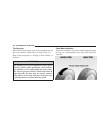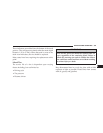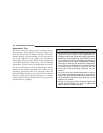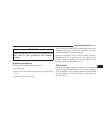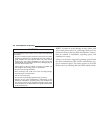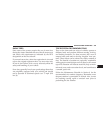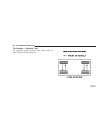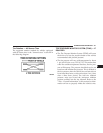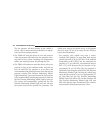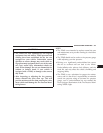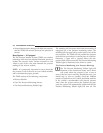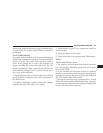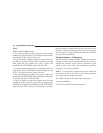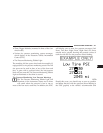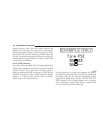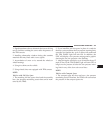
The tire pressure will also increase as the vehicle is
driven - this is normal and there should be no adjust-
ment for this increased pressure.
•
The TPMS will warn the driver of a low tire pressure
if the tire pressure falls below the low-pressure warn-
ing limit for any reason, including low temperature
effects and natural pressure loss through the tire.
•
The TPMS will continue to warn the driver of low tire
pressure as long as the condition exists, and will not
turn off until the tire pressure is at or above the
recommended cold placard pressure. Once the low tire
pressure warning (Tire Pressure Monitoring Telltale
Light) illuminates, you must increase the tire pressure
to the recommended cold placard pressure in order for
the Tire Pressure Monitoring Telltale Light to turn off.
The system will automatically update and the Tire
Pressure Monitoring Telltale Light will turn off once
the system receives the updated tire pressures. The
vehicle may need to be driven for up to 10 minutes
above 15 mph (25 km/h) in order for the TPMS to
receive this information.
−
For example, your vehicle may have a recom-
mended cold (parked for more than three hours)
placard pressure of 30 psi (207 kPa). If the ambient
temperature is 68°F (20°C) and the measured tire
pressure is 27 psi (186 kPa), a temperature drop to
20°F (-7°C) will decrease the tire pressure to ap-
proximately 26 psi (179 kPa). This tire pressure is
sufficiently low enough to turn ON the Tire Pressure
Monitoring Telltale Light. Driving the vehicle may
cause the tire pressure to rise to approximately 27
psi (186 kPa), but the Tire Pressure Monitoring
Telltale Light will still be ON. In this situation, the
Tire Pressure Monitoring Telltale Light will turn
OFF only after the tires are inflated to the vehicle’s
recommended cold placard pressure value.
312 STARTING AND OPERATING



